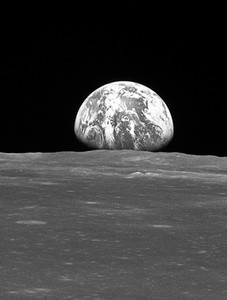Our particular planet in the solar system. The Earth is often assumed to be a sphere with a radius of approximately 6400km. A more accurate accepted value is 6371km. A better approximation is to say that the Earth is in the shape of an oblate spheroid with an equatorial radius of 6378km and a polar radius of 6357km. The mass of the Earth is 5.976×1024kg.
The third planet from the Sun. At perihelion each January it is 147 099 590 km from the Sun, as against 152 096 150 km at aphelion in July. Its mean distance is 149 597 870.7 km. Seen from far off in space it has a strong blue coloration. The Earth is slightly ellipsoidal in shape (equatorial diameter 12 756 km, polar diameter 12 714 km). Its age is 4.57 × 109 years.
Earth
Physical data
Diameter (equatorial)
Oblateness
Inclination of equator to orbit
Axial rotation period (sidereal)
12 756 km
0.0034
23°.44
23.934 hours
Mean density
Mass
Mean albedo (geometric)
Escape velocity
5.52 g/cm3
5.974 × 1024 kg
0.37
11.19 km/s
Orbital data
Mean distance from Sun
106 km
au
Eccentricity of orbit
Inclination of orbit to ecliptic
Orbital period (sidereal)
149.598
1.0
0.017
0°.0
365.256 days
The Earth’s atmosphere is composed (by volume) of 78% nitrogen, 21% oxygen, and 0.9% argon, plus carbon dioxide (0.04%) and other gases in much smaller quantities. Water vapour is also present in variable amounts, typically 1–2%. White clouds of condensed water vapour may obscure a quarter of the Earth’s surface at a time, belts of cloud being common around the equator and at temperate and polar latitudes. The pressure of the atmosphere at sea level varies around 1000 mbar. The average atmospheric temperature at the surface is 15°C, but ranges from −50°C average in winter in Siberia up to +40°C in the Sahara in summer. The Earth’s atmosphere has five distinct layers: the troposphere (up to 10 or 15 km, depending on latitude and season); the stratosphere (from the tropopause to 50 km); the mesosphere (50–85 km); the thermosphere (85–500 km), which includes the ionosphere; and the exosphere (500 km and above).
Liquid water covers 71% of the Earth’s surface. Volcanism and impact cratering occur; more than 500 volcanoes are presently known to have been active on land over the course of recorded human history. Impact cratering was an important process early in the Earth’s history, but the atmosphere now protects the surface from all but the largest impactors. About 190 impact crater sites have been found on the Earth, but most are old and heavily eroded. The dominant geological process on the Earth’s surface is erosion and deposition by water or ice. Liquid water is also responsible for the development of life, which has itself played an important role in transforming the landscape.
The Earth’s outer layer is the lithosphere, topped by the crust, which together vary in thickness between 70 km in parts of the oceans to 150 km in the thickest parts of the continents. Below this is the mantle, which stretches down to a depth of about 2900 km, where the iron–nickel core begins. This core has allowed the development of a magnetic field, which attains a strength of about 3 × 10–5 tesla near the equator. Convection within the mantle, coupled with the thin crust, has given rise to plate tectonics and continental drift, creating vast ranges of mountains and the ocean deeps. The Earth has one natural satellite, the Moon.
 http://earthobservatory.nasa.gov/Features/BlueMarble/BlueMarble_2002.php
http://earthobservatory.nasa.gov/Features/BlueMarble/BlueMarble_2002.php
The third planet from the Sun. It is almost spherical, flattened slightly at the poles, and is composed of five concentric layers: inner core, outer core, mantle, crust, and atmosphere. About 70% of the surface (including the north and south polar ice caps) is covered with water. The Earth is surrounded by a life-supporting atmosphere and is the only planet on which life is known to exist.
The Earth was formed with the rest of the Solar System by consolidation of interstellar dust. Life began 3.5–4 billion years ago.

The Earth rising above the Moon’s horizon, as seen from the Apollo 11 spacecraft in July 1969.
Credit: NASA
http://solarsystem.nasa.gov/planets/earth/overview A wonderful overview of our home planet, including 10 ‘need-to-know things’, an Earth timeline, views of Earth from the outer Solar System, and more.
The third planet in the solar system, outwards from the Sun. The mean distance of the Earth from the Sun is 149.6 × 106 km. This distance provides the standard ‘astronomical unit’ (AU) of measurement. The Earth has a mean radius of 6371 km, density of 5517 kg/m3, and a mass of 5.99 × 1027 g. The oceanic (5–7 km thick) and continental (40 km thick) crusts are separated by the Mohorovičić discontinuity from the silicate mantle, which extends to the Gutenberg discontinuity at 2900 km depth, and overlies a molten, iron-rich core. The oldest rocks are about 3980 million years old, and the Earth formed about 4600 million years ago.
- triangle of forces(in mechanics)
- triangle of loss
- triangle of vectors
- triangle zone
- triangular diagrams
- triangular distribution
- triangular facet
- triangular irregular network
- magnetic transition temperature
- magnetic trap
- magnetic tuning
- magnetic variable
- magnetic variation
- magnetic variations
- magnetism
- magnetite
- magnetization
- magnetization curve
- magnetization(symbol: M; unit: ampere per metre)
- magnetize
- magnetizing force
- magneto
- magnetobremsstrahlung
- magnetocaloric effect
- magnetochemistry